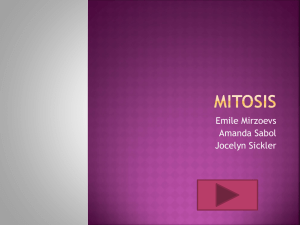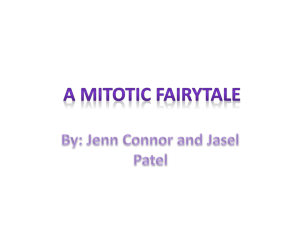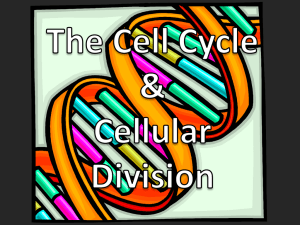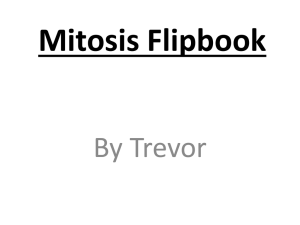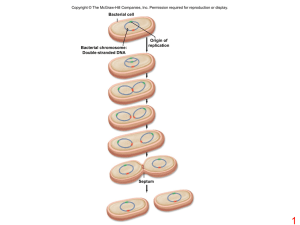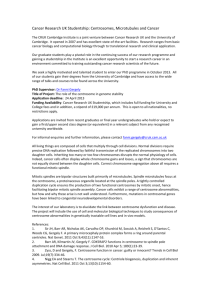Chapter 12: The Cell Cycle
advertisement
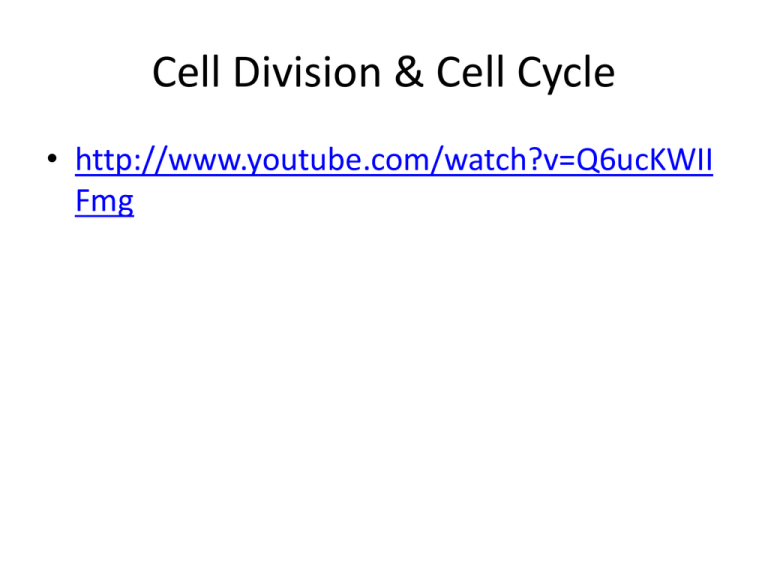
Cell Division & Cell Cycle • http://www.youtube.com/watch?v=Q6ucKWII Fmg Chapter 12: The Cell Cycle DO NOW: Take out HW http://highered.mcgrawhill.com/olc/dl/120073/bio14.swf Omnis cellula e cellula From every cell a cell – Rudolf Virchow • Cell division: reproduction of cells • Cell cycle: life of a cell from the time it is first formed from a dividing parent cell until it divides into 2 daughter cells • Mitosis: nuclear division within a cell, followed by cytokinesis • Cytokinesis: division of the cytoplasm – It is crucial that genetic material remains the same from generation to generation Mitosis • Mitosis functions in – Reproduction of single-celled organisms – Growth – Repair – Regeneration • In contrast, meiosis produces gametes in sexually-reproducing organisms – Contains half the number of chromosomes of a somatic cell Organization of the Genetic Material • Cell division results in genetically identical daughter cells – This requires DNA replication followed by division of the nucleus • Genome: genetic content of the cell – Prokaryotic cells have circular DNA Circular DNA: a single long molecule – Eukaryotic cells contain a number of DNA molecules specific to different species One eukaryotic cell has about 2 meters of DNA The DNA molecules in a cell are packaged into chromosomes – Eukaryotic chromosomes consist of chromatin, a complex of DNA and protein that condenses during cell division – Euchromatin: less condensed and readily available for transcription – Heterochromatin: highly compacted during interphase and therefore not transcribed • Somatic cells: include all body cells, aside from reproductive cells • Gametes: reproductive cells, include sperm and egg Distribution of Chromosomes During Cell Division • Non-dividing cells contain chromatin – In human cells there are 46 strands of chromatin, or 23 corresponding pairs of strands • Dividing cells contain chromosomes – Chromosomes becomes condensed prior to mitosis – Chomrosomes contain sister chromatids bound by a centromere • Centromere contains kinetochore • Kinetochore: a structure of proteins associated with specific sections of chromosomal DNA at the centromere Chromosome Structure 0.5 µm A eukaryotic cell has multiple chromosomes, one of which is represented here. Before duplication, each chromosome has a single DNA molecule. Chromosome duplication (including DNA synthesis) Once duplicated, a chromosome consists of two sister chromatids connected at the centromere. Each chromatid contains a copy of the DNA molecule. Mechanical processes separate the sister chromatids into two chromosomes and distribute them to two daughter cells. Figure 12.4 Centromere Separation of sister chromatids Centromeres Sister chromatids Sister chromatids Mitotic Phase Alternates with Interphase in Cell Cycle • Mitosis: M Phase includes mitosis and cytokinesis – – – – – Prophase Prometaphase Metaphase Anaphase Telophase • Interphase: 90% of cell cycle; cell grows, producing organelles and proteins – G1: First gap – S: Synthesis, chromosome replication – G2: Second gap; completes preparation for cell division INTERPHASE G1 S (DNA synthesis) G2 In 24 hours… • Mitosis: 1 hour • G1: 5-6 hours (most variable) • S: 10-12 hours INTERPHASE • G2: 4-6 hours G1 S (DNA synthesis) G2 Mitotic Spindle is Necessary for Nuclear Division Aster Centrosome • Mitotic spindle: used to segregate sister chromatids in anaphase • Consists of microtubules Overlapping and proteins nonkinetochore microtubules • Microtubules are able to Kinetochores microtubules Microtubules change in length Sister chromatids Metaphase Plate Kinetochores 0.5 µm Chromosomes – Elongate by adding Tubulin subunits – Shorten by loss of Tubulin subunits Centrosome 1 µm Mitotic Spindle • Interphase: the centrosome is replicated and the two centrosomes remain paired near the nucleus – Centrosome or Microtubule Organizing Center (MTOC): contains two centrioles • Prophase: spindle formation • Early Prophase: migration of centrosomes to poles, spindle microtubules grow • Late Prophase: centrosomes are at the poles, asters form – Aster: radial array of short microtubules – The mitotic spindle includes the centrosomes, spindle microtubules and asters Mitotic Spindle Prometaphase: • Kinetochore: protein structure assiciated with specific sections of the chromosomal DNA at the centromere • Kinetochore microtubules: attach kinetochore to spindle • Metaphase Plate: created as microtubules attach to kinetochore, creation indicates Metaphase starts Cellular Changes Indicate M- Phase Initiation G2 of Interphase: nuclear envelope intact – Nucleus and nucleolus present – Centrosome Replication • Animal cells contain centrioles – Chromosomes are not condensed and therefore not individually visible Prophase • Nucleoli disappear • Chromosomes condense • Sister chromatids form – Two genetically identical arms joined by the centromere and cohesin proteins – Mitotic spindle forms using microtubules; asters form – Centrosome migration as microtubules lengthen Prometaphase • Nuclear envelope fragments and microtubules invade nuclear area • Nonkinetochore microtubules elongate • Chromosomes condense further and gain kinetochore proteins • Spindle fibers (microtubules) interact with kinetochores Metaphase • Longest stage of mitosis – Can last up to 20 minutes • Metaphase plate: site of chormosome alignment • Centrosomes are at poles • Sister chromatid kinetochores attach to kinetochore microtubules Anaphase • Shortest stage of mitosis • Cohesins between sister chromatids are cleaved by enzymes – Sister chromatids are now separate chromosomes • Spindle fibers shorten causing chromosomes to move to opposite poles – Spindles shorten at kinetochore ends according to Borisy et al. – Evidenced by Tubulin break down near fluorescently-labeled kinetochores in pig kidney cells • Nonkinetochore microtubules elongate cell Telophase • Daughter nuclei form in cell • Chromosomes loosen and become less dense • Nucleoli reappear Cytokinesis • Occurs in animal cells only • Relies on cleavage marked by a cleavage currow • Cytoplasmic side of cleavage furrow contains actin microfilaments and myosin – As the actin and myosin interact the ring contracts and the cleavage furrow deepens Cellular Division in Plant Cells • Plant cells form a cell plate following mitosis • Golgi vesicles contain cell wall materials and migrate toward the center of the cell – forming the cell plate Binary Fission • Asexual eukaryotes can utilize mitosis for reproductive purposes – this is called binary fission • Asexual prokaryotes perform binary fission that does not involve mitosis Evolution of Mitosis • Some proteins were highly conserved • In prokaryotes, protein resembling eukaryotic actin may help with cell division – Tubulin-Like proteins may help separate daughter cells Attach to nuclear envelope Reinforce spatial arrangement of nucleus Spindle inside nucleus Cell Cycle Regulation •Cytoplasmic regulators as shown in Mammalian cell Fusion experiment by Johnson and Rao (1970) Cell Cycle Control System • Control systems vary cell to cell – Skin cells divide frequently, liver cells only divide when needed (after injury), and nerve and muscle cells never divide • Cytoplasmic molecules signal cell cycle as shown by Johnson and Rao • Cell cycle events are regulated cyclicly – These are referred to as Cell Cycle Checkpoints Cell Cycle Control Systems • Cell Cycle Checkpoint: control point in cell cycle where stop and go-ahead signals can regulate the cycle; relies on signal transduction pathways controlled by internal and external molecular signals – G1 checkpoint: acts as a mammalian restriction point • “Go Signal” permits G1, S, G2 and M • “Stop signal” causes G0 phase: nondividing state, state of most human cells – G2 checkpoint – M checkpoint Cell Cycle Clock • The rate of cell cycle is controlled by two proteins: – Cyclins – Cyclin-dependent kinases (Cdks) Cell Cycle Clock • Kinases: activate or inactivate other proteins via phosphorylation – Inactive most of the time – Kinases are activated by cyclins • Cyclins: regulatory proteins that have a cyclic (fluctuating) concentration in the cell • Cyclin-dependent kinases (Cdks) – Activity fluctuates with cyclin concentration Cell Cycle Clock • MPF: maturationpromoting factor or Mphase promoting factor – MPF is a Cyclin-Cdk complex • Triggers cell passage from G2 to M • G2 checkpoint: As cyclin builds during G2 it binds with Cdk – Resulting MPF phosphorylates proteins, initiating Mitosis • During anaphase, MPF inhibits itself by destroying its own cyclin – Cdk persists in the cell Stop and Go Signals • Internal signals – M Phase checkpoint relies on kinetochore signaling – Allows for enzymatic cleavage of cohesins • External factors – Nutrients – Growth Factor Dependency – Density-dependent inhibition – Anchorage dependence External Factors • Growth Factor Dependency: over 50 known – Platelet-derived Growth Factor (PDGF): made by platelets, required for fibroblast division in culture, used at injury sites in animals – Fibroblasts have PDGF receptors • PDGF receptors are receptor tyrosine kinases • Density-Dependent Inhibition: corwded cells stop dividing – Cell surface protein binds the adjoining cell sends a growthinhibiting signal to cells • Anchorage Dependence: cells require a growth substratum Cancer Cells • Lack response to cell signals – Some can divide indefinitely (ex: HeLa cervical cancer cells) – Cancer cells are not density or anchorage dependent • Cancer starts with transformation – Normal cell becomes cancerous; this occurs regularly and is usually amended by the immune system – If not, the cancer cell divides and becomes a tumor Cancer Cells • Benign tumors: can be removed by surgery • Malignant tumors: invade surrounding tissues and organs, and often metastasize – Metastasis: spread of cancer to far locations in the body • Treatment options – Radiation: destroys cancer cells – Chemotherapy: medication that targets rapidly dividing cells (including cancer cells) • Ex: Taxol – stops dividing cells by prevents microtubule depolymerization in metaphase, but also affects cells that naturally divide often such as intestinal cells and skin cells of hair follicles
